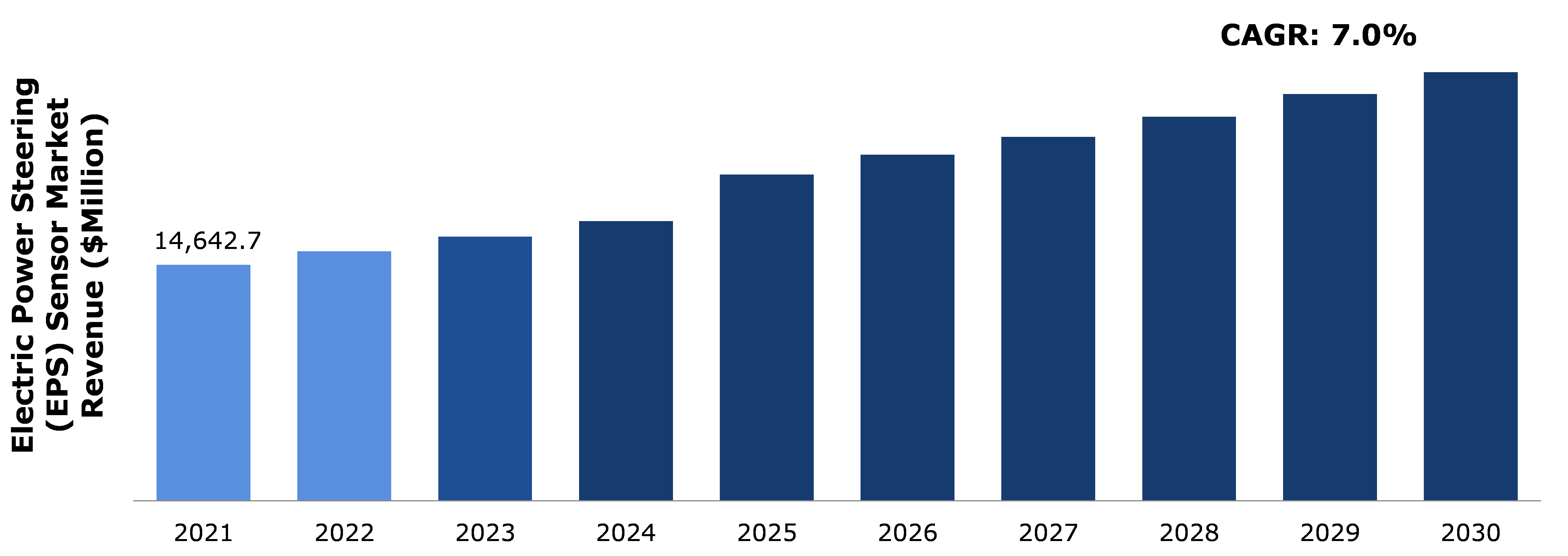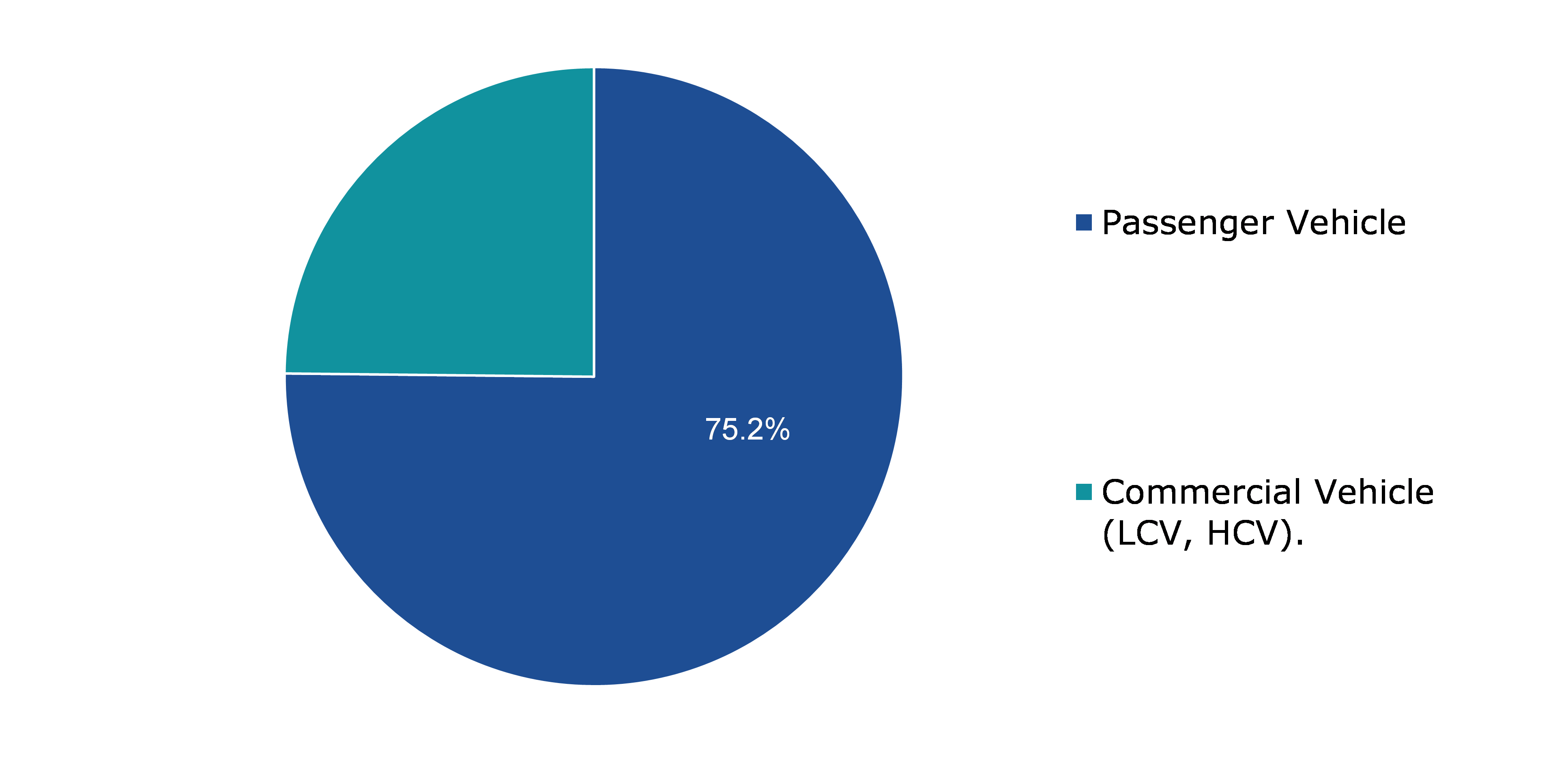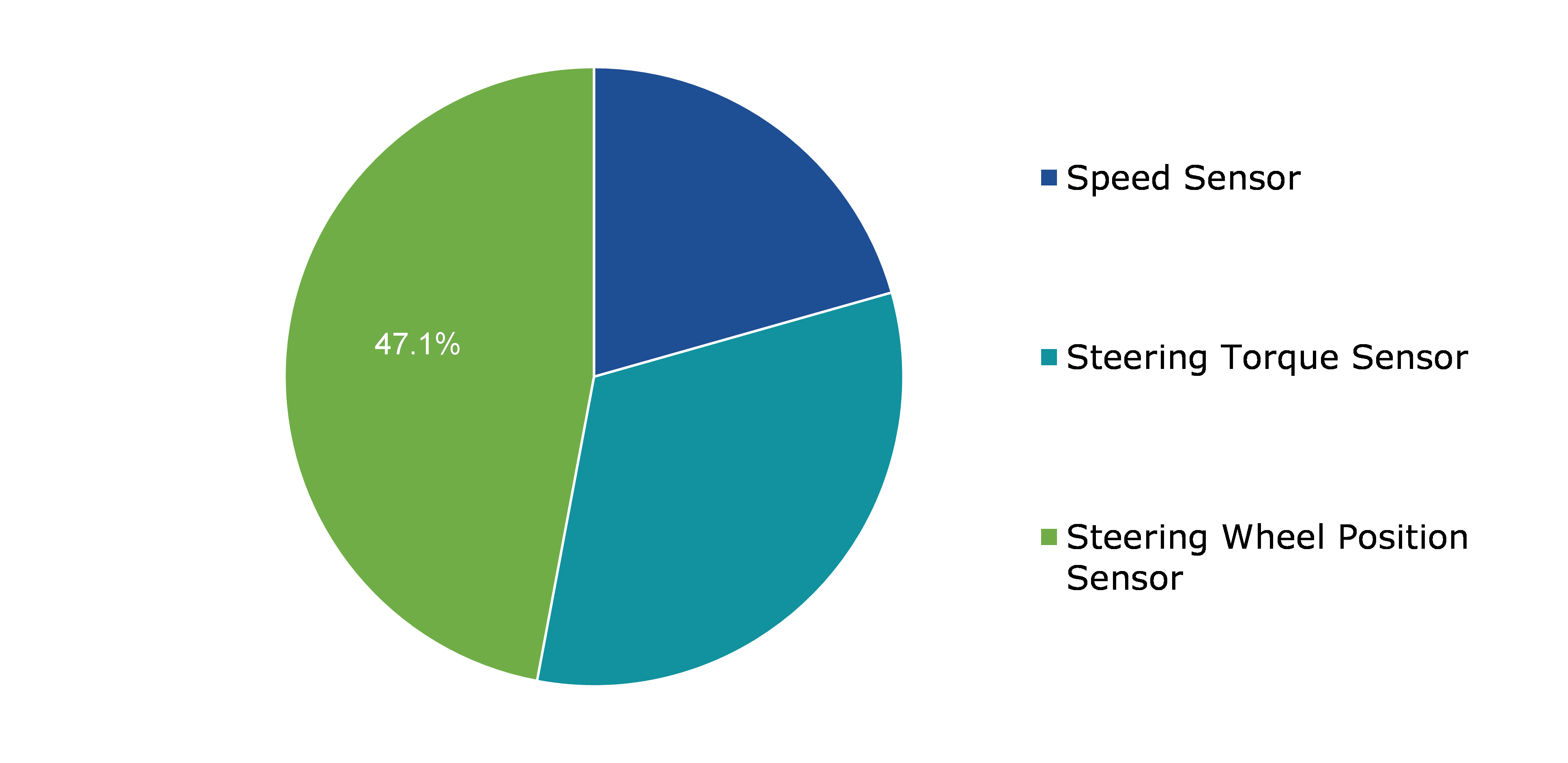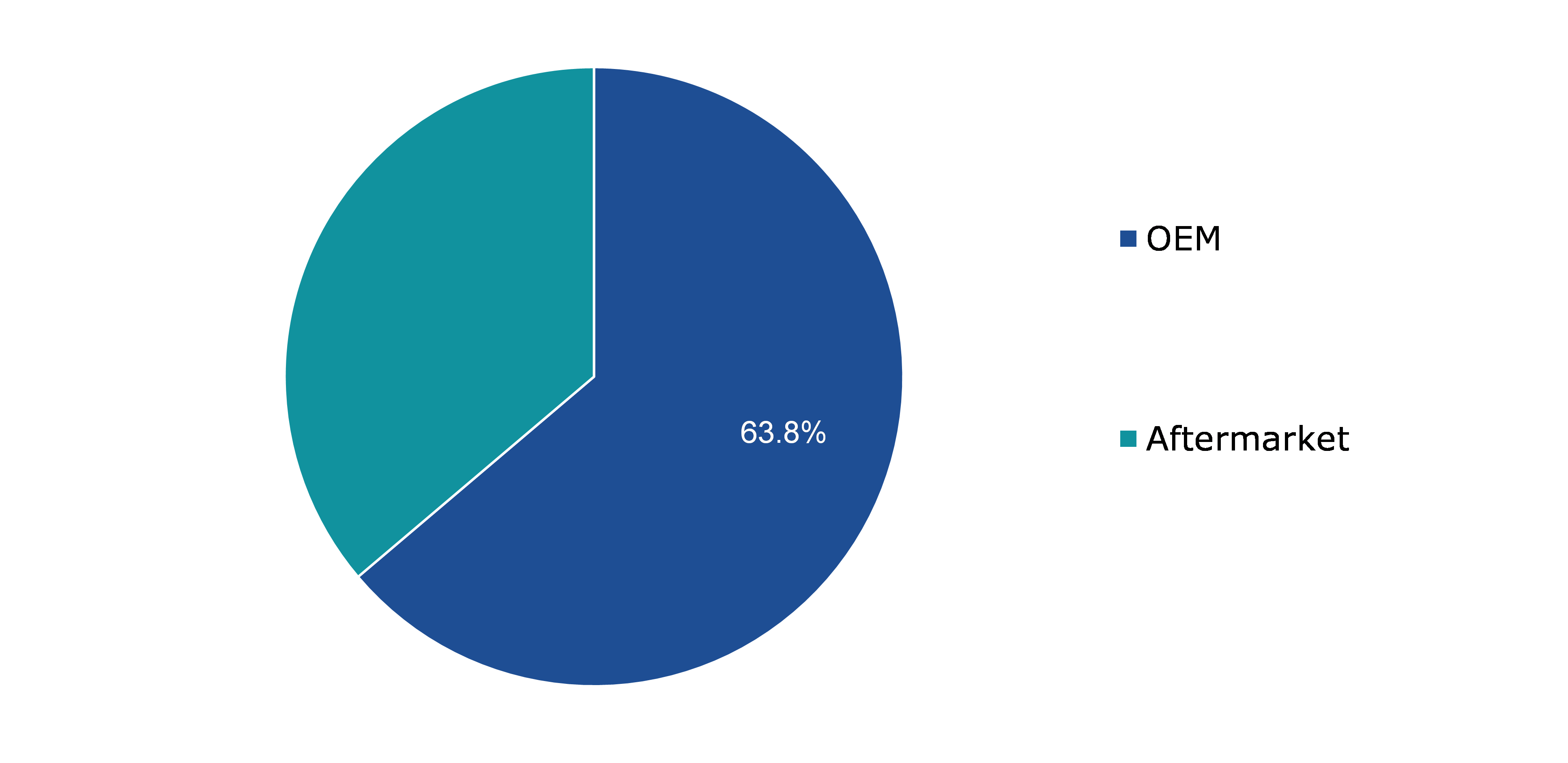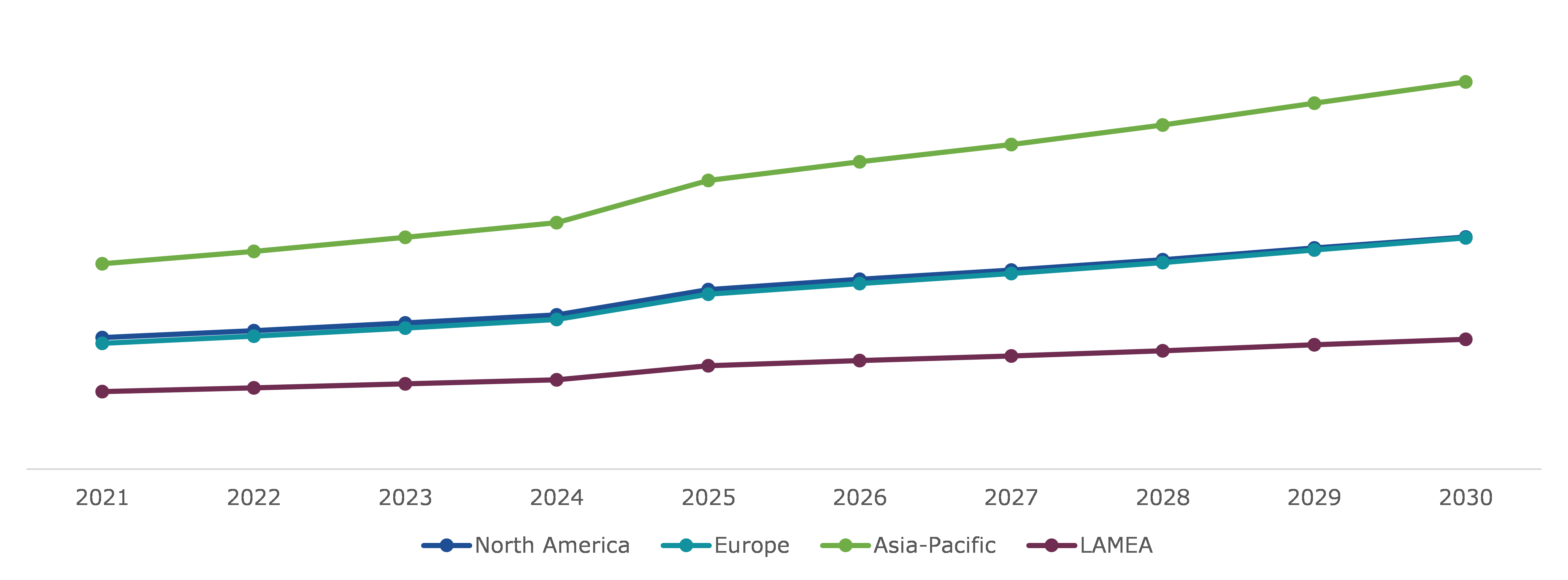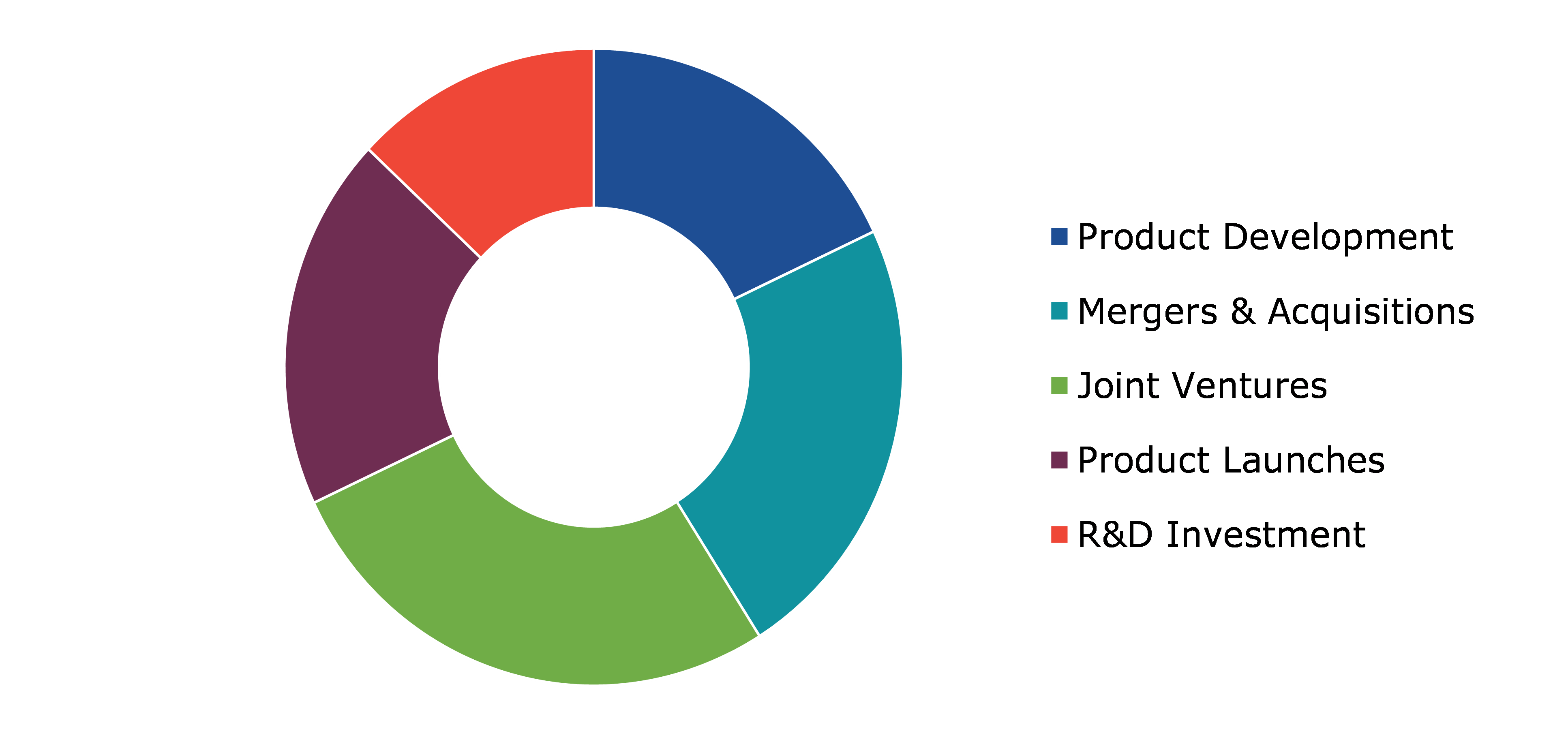Electric Power Steering (EPS) Sensor Market Report
RA08516
Electric Power Steering (EPS) Sensor Market by Vehicle Type (Passenger and Commercial), Sensor Type (Speed Sensor, Steering Torque Sensor, and Steering Wheel Position Sensor), Distribution Channel (Original Equipment Manufacturer (OEM) and Aftermarket), and Regional Analysis (North America, Europe, Asia-Pacific, and LAMEA): Global Opportunity Analysis and Industry Forecast, 2022–2030
Global Electric Power Steering (EPS) Sensor Market Analysis
The global Electric Power Steering (EPS) sensor market size was $14,642.7 million in 2021 and also predicted to grow with CAGR of 7.0%, by generating revenue of $26,580.8 million by 2030.
Global Electric Power Steering (EPS) Sensor Market Synopsis
The Electric Power Steering (EPS) sensors are suitable for light commercial vehicles as well as compact, midsize, and sports cars. It is an essential technology for fully autonomous driving experience. The steering of the vehicle is managed by an electric motor inside the EPS. The EPS manages and supports vehicle steering with the use of an electric motor, offering the driver with a satisfying and ideal steering experience. The latest generation of control units also offers security in the event of accident.
Increase in vehicle production to fulfill underlying demand aroused due to increase in economy. According to Federation of Automobile Dealers Associations (FADA), May 2022 witnessed a 207% increase in automobile retail sales over the corresponding month in the previous year. In May 2022, 1,646,773 units were sold overall compared to 536,795 units in May 2021. However, overall vehicle retails have decreased by 9.66% as compared to May 2019, when 1,822,900 vehicles were sold. Even though May 2020 and May 2021 both experienced a countrywide lockdown because of COVID-19, YoY comparison with May 2021, reveals an unusually high growth rate across all categories. Inflation has decreased as a result of the drop in excise duty on gasoline costs, which is projected to boost sales of automobiles.
In older systems of cars, if a sensor or other component in the steering system failed or began to produce out-of-range data such as speed or angle of wheel, self-diagnostics would detect the fault and, more likely, disable the power-assist. When turning the vehicle, a warning light will illuminate to alert the driver, and the driver will notice a significant increase in steering effort. The system's goal is to avoid the electric motor from overheating and causing damage. Due to this failure it is likely to restrain the Electric Power Steering (EPS) sensor market revenue growth.
Every year, more than 1.3 million people are killed in road accidents around the world, with cyclists, pedestrians, and motorcyclists accounting for more than half of those are killed. For instance, Nexteer, a leading Electric Power Steering (EPS) sensor manufacturer, introduced a technology ‘Vehicle-to-Everything’ (V2X) which is a communication and driver-assistance system. Implementing this sensor in car as well as in bicycles, will warn both car driver and bicycle rider before any collision. This will help in reducing accidents and is likely to create opportunities for key players in the market in near future.
According to regional analysis, the Asia-Pacific electric power steering sensor market accounted for $5,567.2 million in 2021 and is predicted to grow with a CAGR of 7.5% in the projected timeframe.
Electric Power Steering (EPS) Sensor Market Overview
Electric power steering (EPS) sensors are used in the vehicle's power steering system for efficient handling and operation. The EPS system is a replacement for other traditional steering systems such as hydraulic power steering and electro-hydraulic systems. Rising importance of self-driving or autonomous vehicles is expected to fuel the market growth of EPS systems, thereby increasing growth of the EPS sensors. The use of an EPS system in a vehicle, which includes an electric power steering pump, a power steering motor, and sensors, helps to reduce overall weight, improve fuel efficiency, and extend vehicle life.
COVID-19 Impact on Electric Power Steering (EPS) Sensor Market
The spread of COVID-19 caused the global economy to start dropping dramatically in early 2020, which was the start of the fiscal year that ended on March 31, 2021. Corporate profits reached their lowest points in April and May 2020, May 2020 was the lowest point in global automotive manufacturing and exports before beginning a recovery trend. Uncertainty and reduced profits meant reduction in investment in various automobile parts for advancement. However, due to the unstable environment created by the COVID-19 pandemic and lack of resources, vehicle manufacturing globally fell in comparison to the previous year. Furthermore, shortages in semiconductor caused by supply chain disruption harmed the market in various sectors. The semiconductor shortages led to disruption in automobile production as semiconductors are used in the various components of automobile. For example, the semiconductor used in EPS sensor monitors, interpret and controls the steering mechanism for better performance of steering in vehicles.
However the year 2021, saw the rise in automobile demand compared to 2020, but could not perform strong enough compared to 2019 sales figures due to uncertainty of pandemic’s second phase.
Reduced Stress on the Engine and Increase in Fuel Efficiency Due to Electric Power Steering (EPS) Sensor to Drive the Market Growth.
The Electric Power Steering (EPS) used in cars has components such as motor, sensor, and steering column. In comparison to Hydraulic Power Steering (HPS), the EPS uses electric motor to assists the driver to steer the car rather than drawing power from the engine to run hydraulic system to steer the car. Thus reduction of stress on engine, increases the fuel efficiency of engine. Increase in fuel prices is leading to rise in sale of fuel efficient cars, thus it is further expected to drive the Electric Power Steering (EPS) sensor market demand.
The Electric Power Steering (EPS) sensor continuously monitors the driver behavior on steering movement, road condition, speed, and tire movement. The Advanced Driver Assisted Systems (ADAS) plays important role in avoiding accidents caused by human error. The ADAS controls various elements in cars such as pedestrian detection/avoidance, lane departure warning/correction, traffic sign recognition, automatic emergency braking, and blind spot detection. During the high speed of vehicle, various factors such as slippery roads or sudden braking can cause imbalance of the vehicle. With help of ADAS such as EPS, ABS, and steering wheel, more than 80% of skidding accidents can be avoided by using sensor data about the road condition and speed of vehicle. This factor is expected to drive the market share.
Issues with Electric Motor can Lead to Failure of Electronic Power Steering is Expected to Hamper the Market Growth
The electric motor which is mounted on the steering column may lead to failure of electric power steering due to excessive heat. The infiltration of dirt, water, or any contaminants in system are also likely to cause failure of circuit or improper working of moving parts. The failure of sensor due to heat or other factors will cause improper performance of sensor to measure the torque and other factors. The failure of system causes issues such as heavy or rock hard steering and unable to steer or move direction of wheel. With such arising issues it is expected to hamper the electric power steering (EPS) sensor market growth.
The Electric Power Assisted System (EPAS) Innovation in Electric Power Steering (EPS) Sensor to Create the Opportunities in Market
The electric power assisted system is an adaptive steering, modern technology integrated into several modern cars and sport cars. Normally, the steering ratio is fixed in traditional steering system. The adaptive steering changes ratio between the steering wheel and wheel rack according to driver actions on the steering to assist driver for ease in steering as traditional steering system requires more human power to steer the car. The sensors used in the EPS gives input such as speed, road conditions, driver actions, and others to calculate and calibrate the steering according to driver. The steering is optimized in all conditions by changing steering ratio with the speed of the vehicle. It makes easy in turning in tight corners at low speeds and makes smooth operation of steering at high speeds. Adaptive steering assists driver and makes drive more enjoyable. It is anticipated to create the opportunities for key players in Electric Power Steering (EPS) sensor market.
The electric power steering (EPS) sensor market trending in japan. For instance, Yamaha, a world’s leading motorcycle manufacturer, manufactured the Electric Power Steering (EPS) for motorcycle to aid the rider. The company announced it to first try their prototype in race bikes in All Japan Motocross Championship. The magnetostrictive torque sensor is used in motorcycle EPS which measures movement and steering force applied by rider. The expansion of Electric Power Steering (EPS) sensor market in motorcycle sector is expected to create investment opportunities in the motorcycle segment.
Global Electric Power Steering (EPS) Sensor Market, by Vehicle Type
Based on the vehicle type, the market is divided into passenger and commercial vehicles. The passenger sub-segment is expected to garner a maximum revenue and fastest growth in coming years.
Global Electric Power Steering (EPS) Sensor Market Share, by Vehicle Type, 2021
Source: Research Dive Analysis
The passenger vehicle sub-segment is projected to have a dominant market share and generate a revenue of $20,099.7 million by 2030, growing from $11,006.5 million in 2021. Most of the passenger vehicles are cars and sports utility vehicles. Rising popularity of passenger cars as a primary mode of transportation around the world is expected to support revenue growth of the passenger vehicles sub-segment. In 2021, the total global sales of cars was recorded 71.3 million. Currently, 30% of passenger cars globally are equipped with EPS technology, and this technology is expected to be used in low-cost passenger cars. As a result of these developments, the passenger vehicle sub-segment is predicted to grow significantly in the coming years.
The commercial vehicle sub-segment is predicted to show fastest growth and shall generate a revenue of $6,481.1 million by 2030, increasing from $3,636.2 million in 2021. The commercial vehicle sub-segment includes truck, buses, and other heavy vehicles. The heavy vehicles require more power to steer due to their weight. Normally the hydraulic power steering system is used in this sub-segment vehicles to reduce the effort of the driver to steer. New innovation in Electric Power Steering (EPS) sensor such as dual motor mounted on steering shaft and high newton meter force wheel torque sensor to assist driver, such innovations are driving electric power steering’s use in the commercial sub-segment.
Global Electric Power Steering (EPS) Sensor Market, by Sensor Type
Based on sensor type, the market is divided into speed sensor, steering torque sensor, and steering wheel position sensor. Among sensor type segment, the steering torque sensor is predicted to show the fastest growth and steering wheel position sensor is anticipated to hold a dominant market share.
Global Electric Power Steering (EPS) Sensor Market Share, by Sensor Type, 2021
Source: Research Dive Analysis
The steering wheel position sensor sub-segment is predicted to have a dominant market share and generate a revenue of $12,271.3 million by 2030, increasing from $6,889.4 million in 2021. The steering wheel position sensor is placed on the steering shaft which measures the driver input of movement of steering to steer. Sensors in steering systems are being deployed by automotive OEMs to provide proper and accurate response and to automatically adapt to vehicle speed. This improves the roll dynamics of the vehicle by keeping it connected to the road with proper grip and traction. Furthermore, rising demand for safety systems has compelled steering sensor manufacturers to incorporate safety features into their products. These factors are expected to fuel revenue growth of steering wheel position sensor sub-segment.
The steering torque sensor sub-segment show fastest market growth and generate a revenue of $9,119.7 million by 2030, growing from $4,734. million in 2021. The technological innovation in the steering torque sensor such as magnetostrictive sensor, magnetoelastic sensor, optical torque sensor and non-contact torque sensor such as hall sensor is expected to increase efficiency of Electric Power Steering (EPS). Due to their high precision, high linearity, reduced electromagnetic noise has led to use of such sensor in the electric power steering (EPS) system in this modern era.
Global Electric Power Steering (EPS) Sensor Market, by Distribution Channel
Based on distribution channel segment, the market is divided into the Original Equipment Manufacturer (OEM) and aftermarket. The original equipment manufacturer sub-segment is forecasted to show dominant market share and aftermarket sub-segment to show fastest growth in the Electric Power Steering (EPS) sensor market.
Global Electric Power Steering (EPS) Sensor Market Share, by Distribution Channel, 2021
Source: Research Dive Analysis
The original equipment manufacturer sub-segment is predicted to show the dominant market share and generate revenue of $16,739.6 million by 2030, increase from $9,343.2 million in 2021. Increasing demand for cars globally and rising demand for safety are key factors increasing implementation of Electric Power Steering (EPS) sensor as steering system is essential part of cars. Rapid adoption of Electric Power Steering (EPS) sensor by the automotive industry is predicted to manufacture more fuel efficient cars. Thus these trends are driving Electric Power Steering (EPS) sensor market growth.
The aftermarket sub-segment is projected to show fastest market growth and generate a revenue $9,841.2 million by 2030, growing from $5,299.5 million in 2021. Vehicle owners' increasing demand for safety and fuel savings is a key trend driving the market growth. The vehicle owners are switching from hydraulic steering to more energy efficient and reliable electric steering system.
Global Electric Power Steering (EPS) Sensor Market, Regional Insights
The Electric Power Steering (EPS) sensor market was investigated across North America, Europe, Asia-Pacific, and LAMEA.
Global Electric Power Steering (EPS) Sensor Market Size & Forecast, By Region, 2021-2030 (USD Million)
Source: Research Dive Analysis
The Market for Electric Power Steering (EPS) Sensor in Asia-Pacific to be the Most Dominant
The Asia-Pacific Electric Power Steering (EPS) sensor market accounted for $5,567.2 million in 2021 and projected to grow with healthy CAGR of 7.5%. In the Asia-Pacific region, China recorded strong growth in car sales in 2021, becoming the world's largest car market. China’s sales increased by 7% producing more than 21 million vehicles. Followed by Japan and India being the world third and fourth respectively, world’s largest car market. India posted 27% growth in automotive industry in 2021 and is expected to grow further in 2022, as a result of strong demand from Asia-Pacific countries' growing economies and consumer preferences for personal vehicles. In 2021, Indonesia recorded 67% gain in sales volume to ranked fifteenth in world’s car sale list. The increase in demand for electric vehicle in emerging countries’ is expected to post strong growth in Asia-Pacific region. The increase in car production is driving the Electric Power Steering (EPS) sensor market size in this region.
Competitive Scenario in Electric Power Steering (EPS) Sensor Market
The research & development and strategic partnerships are the common strategies followed by major market players. For instance, HELLA, Germany based automotive part supplier, launched CIPOS in 2019, a contact-less inductive position sensor which is precise and free from risk of damaging from mechanical friction.
Source: Research Dive Analysis
Electric Power Steering (EPS) sensor market share has been accounted by key players including Robert Bosch GmbH, DENSO CORPORATION, HELLA GmbH & Co. KGaA, Infineon Technologies AG, NXP Semiconductors, Valeo, Continental AG, Sensata Technologies, Inc., TT Electronics, and Asahi Kasei Corporation.
| Aspect | Particulars |
| Historical Market Estimations | 2020-2021 |
| Base Year for Market Estimation | 2021 |
| Forecast Timeline for Market Projection | 2022-2030 |
| Geographical Scope | North America, Europe, Asia-Pacific, and LAMEA |
| Segmentation by Vehicle Type |
|
| Segmentation by Sensor Type |
|
| Segmentation by Distribution Channel |
|
| Key Companies Profiled |
|
Q1. What is the size of the global Electric Power Steering (EPS) sensor market?
A. The size of global of global Electric Power Steering (EPS) sensor market was $14,642.7 million in 2021 and is predicted to reach $26,580.8 million by 2030.
Q2. Which are the major companies in the Electric Power Steering (EPS) sensor market?
A. Robert Bosch GmbH, HELLA GmbH & Co. KgaA, DENSO Corporation, Valeo SA, Continental AG, and Infineon Technology are the key players in Electric Power Steering (EPS) sensor market.
Q3. Which region, among others, possesses greater investment opportunities in the near future?
A. The Asia-Pacific region possesses great investment opportunities for investors to witness the most promising growth in the future.
Q4. What will be the growth rate of the Asia-Pacific EPS sensor market?
A. Asia-Pacific Electric Power Steering (EPS) sensor market size is anticipated to grow at 7.5% CAGR during the forecast period.
Q5. What are the strategies opted by the leading players in this market?
A. Research & development and strategic partnerships to enhance its product portfolio offerings are the two key strategies opted by the operating companies in this market.
Q6. Which companies are investing more on R&D practices?
A. Steering sensors aNXP Semiconductors, Robert Bosch GmbH, and DENSO Corporation are the companies investing more in R&D practices.re used for sensing the steering wheel's rotational angle, convert applied torque into electric signal, and also communicating navigational information.
1.Research Methodology
1.1.Desk Research
1.2.Real time insights and validation
1.3.Forecast model
1.4.Assumptions and forecast parameters
1.5.Market size estimation
1.5.1.Top-down approach
1.5.2.Bottom-up approach
2.Report Scope
2.1.Market definition
2.2.Key objectives of the study
2.3.Report overview
2.4.Market segmentation
2.5.Overview of the impact of COVID-19 on Global electric power Steering (EPS) sensor market
3.Executive Summary
4.Market Overview
4.1.Introduction
4.2.Growth impact forces
4.2.1.Drivers
4.2.2.Restraints
4.2.3.Opportunities
4.3.Market value chain analysis
4.3.1.List of raw material suppliers
4.3.2.List of manufacturers
4.3.3.List of distributors
4.4.Innovation & sustainability matrices
4.4.1.Technology matrix
4.4.2.Regulatory matrix
4.5.Porter’s five forces analysis
4.5.1.Bargaining power of suppliers
4.5.2.Bargaining power of consumers
4.5.3.Threat of substitutes
4.5.4.Threat of new entrants
4.5.5.Competitive rivalry intensity
4.6.PESTLE analysis
4.6.1.Political
4.6.2.Economical
4.6.3.Social
4.6.4.Technological
4.6.5.Environmental
4.7.Impact of COVID-19 on electric power steering (EPS) sensor market
4.7.1.Pre-covid market scenario
4.7.2.Post-covid market scenario
5.Electric Power Steering (EPS) Sensor Market Analysis, by Vehicle Type
5.1.Overview
5.2.Passenger Vehicle
5.2.1.Definition, key trends, growth factors, and opportunities, 2021-2030
5.2.2.Market size analysis, by region, 2021-2030
5.2.3.Market share analysis, by country, 2021-2030
5.3.Commercial Vehicle
5.3.1.Definition, key trends, growth factors, and opportunities, 2021-2030
5.3.2.Market size analysis, by region, 2021-2030
5.3.3.Market share analysis, by country, 2021-2030
5.4.Research Dive Exclusive Insights
5.4.1.Market attractiveness, 2021-2030
5.4.2.Competition heatmap, 2021-2030
6.Electric Power Steering (EPS) Sensor Market Analysis, by Sensor Type
6.1.Speed Sensor
6.1.1.Definition, key trends, growth factors, and opportunities, 2021-2030
6.1.2.Market size analysis, by region, 2021-2030
6.1.3.Market share analysis, by country, 2021-2030
6.2.Steering Torque Sensor
6.2.1.Definition, key trends, growth factors, and opportunities, 2021-2030
6.2.2.Market size analysis, by region, 2021-2030
6.2.3.Market share analysis, by country, 2021-2030
6.3.Steering Wheel Position Sensor
6.3.1.Definition, key trends, growth factors, and opportunities, 2021-2030
6.3.2.Market size analysis, by region, 2021-2030
6.3.3.Market share analysis, by country, 2021-2030
6.4.Research Dive Exclusive Insights
6.4.1.Market attractiveness, 2021-2030
6.4.2.Competition heatmap, 2021-2030
7.Electric Power Steering (EPS) Sensor Market Analysis, By Distribution Channel
7.1.OEM
7.1.1.Definition, key trends, growth factors, and opportunities, 2021-2030
7.1.2.Market size analysis, by region, 2021-2030
7.1.3.Market share analysis, by country, 2021-2030
7.2.Aftermarket
7.2.1.Definition, key trends, growth factors, and opportunities, 2021-2030
7.2.2.Market size analysis, by region, 2021-2030
7.2.3.Market share analysis, by country, 2021-2030
7.3.Research Dive Exclusive Insights
7.3.1.Market attractiveness, 2021-2030
7.3.2.Competition heatmap, 2021-2030
8.Electric Power Steering (EPS) Sensor Market, by Region
8.1.North America
8.1.1.U.S.
8.1.1.1.Market size analysis, by Vehicle Type, 2021-2030
8.1.1.2.Market size analysis, by Sensor Type, 2021-2030
8.1.1.3.Market size analysis, by Distribution Channel, 2021-2030
8.1.2.Canada
8.1.2.1.Market size analysis, by Vehicle Type, 2021-2030
8.1.2.2.Market size analysis, by Sensor Type, 2021-2030
8.1.2.3.Market size analysis, by Distribution Channel, 2021-2030
8.1.3.Mexico
8.1.3.1.Market size analysis, by Vehicle Type, 2021-2030
8.1.3.2.Market size analysis, by Sensor Type, 2021-2030
8.1.3.3.Market size analysis, by Distribution Channel, 2021-2030
8.1.4.Research Dive Exclusive Insights
8.1.4.1.Market attractiveness, 2021-2030
8.1.4.2.Competition heatmap, 2021-2030
8.2.Europe
8.2.1.Germany , 2021-2030
8.2.1.1.Market size analysis, by Vehicle Type, 2021-2030
8.2.1.2.Market size analysis, by Sensor Type, 2021-2030
8.2.1.3.Market size analysis, by Distribution Channel, 2021-2030
8.2.2.U.K.
8.2.2.1.Market size analysis, by Vehicle Type, 2021-2030
8.2.2.2.Market size analysis, by Sensor Type, 2021-2030
8.2.2.3.Market size analysis, by Distribution Channel, 2021-2030
8.2.3.France
8.2.3.1.Market size analysis, by Vehicle Type, 2021-2030
8.2.3.2.Market size analysis, by Sensor Type, 2021-2030
8.2.3.3.Market size analysis, by Distribution Channel, 2021-2030
8.2.4.Spain
8.2.4.1.Market size analysis, by Vehicle Type, 2021-2030
8.2.4.2.Market size analysis, by Sensor Type, 2021-2030
8.2.4.3.Market size analysis, by Distribution Channel, 2021-2030
8.2.5.Italy
8.2.5.1.Market size analysis, by Vehicle Type, 2021-2030
8.2.5.2.Market size analysis, by Sensor Type, 2021-2030
8.2.5.3.Market size analysis, by Distribution Channel, 2021-2030
8.2.6.Rest of Europe
8.2.6.1.Market size analysis, by Vehicle Type, 2021-2030
8.2.6.2.Market size analysis, by Sensor Type, 2021-2030
8.2.6.3.Market size analysis, by Distribution Channel, 2021-2030
8.2.7.Research Dive Exclusive Insights
8.2.7.1.Market attractiveness, 2021-2030
8.2.7.2.Competition heatmap, 2021-2030
8.3.Asia-Pacific
8.3.1.China
8.3.1.1.Market size analysis, by Vehicle Type, 2021-2030
8.3.1.2.Market size analysis, by Sensor Type, 2021-2030
8.3.1.3.Market size analysis, by Distribution Channel, 2021-2030
8.3.2.Japan
8.3.2.1.Market size analysis, by Vehicle Type, 2021-2030
8.3.2.2.Market size analysis, by Sensor Type, 2021-2030
8.3.2.3.Market size analysis, by Distribution Channel, 2021-2030
8.3.3.India
8.3.3.1.Market size analysis, by Vehicle Type, 2021-2030
8.3.3.2.Market size analysis, by Sensor Type, 2021-2030
8.3.3.3.Market size analysis, by Distribution Channel, 2021-2030
8.3.4.Australia
8.3.4.1.Market size analysis, by Vehicle Type, 2021-2030
8.3.4.2.Market size analysis, by Sensor Type, 2021-2030
8.3.4.3.Market size analysis, by Distribution Channel, 2021-2030
8.3.5.South Korea
8.3.5.1.Market size analysis, by Vehicle Type, 2021-2030
8.3.5.2.Market size analysis, by Sensor Type, 2021-2030
8.3.5.3.Market size analysis, by Distribution Channel, 2021-2030
8.3.6.Rest of Asia-Pacific
8.3.6.1.Market size analysis, by Vehicle Type, 2021-2030
8.3.6.2.Market size analysis, by Sensor Type, 2021-2030
8.3.6.3.Market size analysis, by Distribution Channel, 2021-2030
8.3.7.Research Dive Exclusive Insights
8.3.7.1.Market attractiveness, 2021-2030
8.3.7.2.Competition heatmap, 2021-2030
8.4.LAMEA
8.4.1.Brazil
8.4.1.1.Market size analysis, by Vehicle Type, 2021-2030
8.4.1.2.Market size analysis, by Sensor Type, 2021-2030
8.4.1.3.Market size analysis, by Distribution Channel, 2021-2030
8.4.2.Saudi Arabia
8.4.2.1.Market size analysis, by Vehicle Type, 2021-2030
8.4.2.2.Market size analysis, by Sensor Type, 2021-2030
8.4.2.3.Market size analysis, by Distribution Channel, 2021-2030
8.4.3.UAE
8.4.3.1.Market size analysis, by Vehicle Type, 2021-2030
8.4.3.2.Market size analysis, by Sensor Type, 2021-2030
8.4.3.3.Market size analysis, by Distribution Channel, 2021-2030
8.4.4.South Africa
8.4.4.1.Market size analysis, by Vehicle Type, 2021-2030
8.4.4.2.Market size analysis, by Sensor Type, 2021-2030
8.4.4.3.Market size analysis, by Distribution Channel, 2021-2030
8.4.5.Rest of LAMEA
8.4.5.1.Market size analysis, by Vehicle Type, 2021-2030
8.4.5.2.Market size analysis, by Sensor Type, 2021-2030
8.4.5.3.Market size analysis, by Distribution Channel, 2021-2030
8.4.6.Research Dive Exclusive Insights
8.4.6.1.Market attractiveness, 2021-2030
8.4.6.2.Competition heatmap, 2021-2030
9.Competitive Landscape
9.1.Top winning strategies, 2021
9.1.1.By strategy
9.1.2.By year
9.2.Strategic overview
9.3.Market share analysis, 2021
10.Company Profiles
10.1.Robert Bosch GmbH
10.1.1.Overview
10.1.2.Business segments
10.1.3.Product portfolio
10.1.4.Financial performance
10.1.5.Recent developments
10.1.6.SWOT analysis
10.2.DENSO CORPORATION
10.2.1.Overview
10.2.2.Business segments
10.2.3.Product portfolio
10.2.4.Financial performance
10.2.5.Recent developments
10.2.6.SWOT analysis
10.3.HELLA GmbH & Co. KGaA
10.3.1.Overview
10.3.2.Business segments
10.3.3.Product portfolio
10.3.4.Financial performance
10.3.5.Recent developments
10.3.6.SWOT analysis
10.4. Infineon Technologies AG
10.4.1.Overview
10.4.2.Business segments
10.4.3.Product portfolio
10.4.4.Financial performance
10.4.5.Recent developments
10.4.6.SWOT analysis
10.5.NXP Semiconductors
10.5.1.Overview
10.5.2.Business segments
10.5.3.Product portfolio
10.5.4.Financial performance
10.5.5.Recent developments
10.5.6.SWOT analysis
10.6.Valeo
10.6.1.Overview
10.6.2.Business segments
10.6.3.Product portfolio
10.6.4.Financial performance
10.6.5.Recent developments
10.6.6.SWOT analysis
10.7.Continental AG
10.7.1.Overview
10.7.2.Business segments
10.7.3.Product portfolio
10.7.4.Financial performance
10.7.5.Recent developments
10.7.6.SWOT analysis
10.8.Sensata Technologies, Inc.
10.8.1.Overview
10.8.2.Business segments
10.8.3.Product portfolio
10.8.4.Financial performance
10.8.5.Recent developments
10.8.6.SWOT analysis
10.9.TT Electronics
10.9.1.Overview
10.9.2.Business segments
10.9.3.Product portfolio
10.9.4.Financial performance
10.9.5.Recent developments
10.9.6.SWOT analysis
10.10.Asahi Kasei Corporation
10.10.1.Overview
10.10.2.Business segments
10.10.3.Product portfolio
10.10.4.Financial performance
10.10.5.Recent developments
10.10.6.SWOT analysis
11.Appendix
11.1.Parent & peer market analysis
11.2.Premium insights from industry experts
11.3.Related reports
Electric power steering (EPS) sensors are used in the powers steering system of a vehicle for smooth running and seamless handling of a vehicle. An EPS vehicle comes on in a vehicle that does not have other traditional steering systems like hydraulic and electro-hydraulic power steering systems. An EPS system brings significant value to the vehicle, prolonging vehicle life, enhancing fuel efficiency, and helps in reducing weight of the vehicle.
Forecast Analysis of the Electric Power Steering (EPS) Sensor Market
The rising demand for EPS sensors as it helps in increasing fuel efficiency of the vehicle and the reduces stress on engine are the factors predicted to boost the growth of the electric power steering (EPS) sensor market in the coming future. Besides, initiatives taken by the government across the globe to develop safe and efficient automotive systems is expected to drive the growth of the market during the forecast period. Additionally, increasing adoption of EPS sensors in commercial vehicles across the globe is further expected to create massive opportunities for the growth of the global market. However, extortionate cost of EPS sensors is expected to impede the growth of the market during the forecast period.
According to the report published by Research Dive, the global electric power steering (EPS) sensor market is expected to generate a revenue of $26,580.8 by 2030, growing exponentially at a CAGR of 7.0% from 2021-2028. The major players of the market include Robert Bosch GmbH, HELLA GmbH & Co. KGaA, DENSO CORPORATION, Infineon Technologies AG, Valeo, Continental AG, NXP Semiconductors, Sensata Technologies, Inc., Asahi Kasei Corporation, and TT Electronics.
Key Trends & Developments in the Electric Power Steering (EPS) Sensor Market
The key companies operating in the industry are adopting various growth strategies & business tactics such as partnerships, collaborations, mergers & acquisitions, and launches to maintain a robust position in the overall market, which is subsequently helping the global EPS sensor market to grow exponentially. For instance,
- In March 2019, Renesas Electronics Corporation, a premier supplier of advanced semiconductor solutions, acquired Integrated Device Technology, Inc., a leading supplier of analog mixed-signal products, including sensors, connectivity and wireless power, in order to maximize Renesas’s presence in the global electric power steering (EPS) sensor market.
- In April 2021, Sensata Technologies, a leading industrial technology company and provider of sensor-rich solutions that create insight for customers, acquired Xirgo® Technologies Intermediate Holdings, LLC, a leading telematics and data insight provider, for about $400 million, in order to strengthen its brand portfolio and create new growth opportunities.
- In October 2021, Nexteer Automotive, an American, majority Chinese-owned automotive parts supplier, extends its Electric Power Steering (EPS) portfolio with the introduction of a new system called Modular Column-Assist EPS System (mCEPS). This creative system is extremely economical, and brings significant flexibility to meet an extensive range of OEM (Original Equipment Manufacturer) requirements.
Most Profitable Region
The Asia-Pacific region is expected to be most profitable by growing at a CAGR of 7.5% during the forecast period. Massive investment done by manufacturers in new vehicle technologies in this region is expected to drive the growth of the market during the forecast period. In addition, presence of prominent players of the market in this region is further expected to bolster the growth of the regional electric power steering (EPS) sensor market during the forecast period.
COVID-19 Impact on the Market
The outbreak of COVID-19 has had an adverse impact on the market, owing to the prevalence of lockdowns in various countries across the globe. Lockdowns led to the closure of various industries across the globe including the automobile sector, and hence the demand for automobiles plunged dreadfully. This in turn, terribly impacted the manufacturing of automobile parts, sensors, and others. Thus, the pandemic has had a negative impact on the electric power steering (EPS) sensor market.
Personalize this research
- Triangulate with your own data
- Request your format and definition
- Get a deeper dive on a specific application, geography, customer or competitor
- + 1-888-961-4454 Toll - Free
- support@researchdive.com

